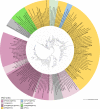SPOC domain proteins in health and disease
- PMID: 36927757
- PMCID: PMC10111866
- DOI: 10.1101/gad.350314.122
SPOC domain proteins in health and disease
Abstract
Since it was first described >20 yr ago, the SPOC domain (Spen paralog and ortholog C-terminal domain) has been identified in many proteins all across eukaryotic species. SPOC-containing proteins regulate gene expression on various levels ranging from transcription to RNA processing, modification, export, and stability, as well as X-chromosome inactivation. Their manifold roles in controlling transcriptional output implicate them in a plethora of developmental processes, and their misregulation is often associated with cancer. Here, we provide an overview of the biophysical properties of the SPOC domain and its interaction with phosphorylated binding partners, the phylogenetic origin of SPOC domain proteins, the diverse functions of mammalian SPOC proteins and their homologs, the mechanisms by which they regulate differentiation and development, and their roles in cancer.
Keywords: SPOC domain; gene expression; phosphorylation.
© 2023 Appel et al.; Published by Cold Spring Harbor Laboratory Press.
Figures













References
-
- Appel LM, Franke V, Benedum J, Grishkovskaya I, Strobl X, Polyansky A, Ammann G, Platzer S, Neudolt A, Wunder A, et al. 2023. The SPOC domain is a phosphoserine binding module that bridges transcription machinery with co- and post-transcriptional regulators. Nat Commun 14: 166. 10.1038/s41467-023-35853-1 - DOI - PMC - PubMed
Publication types
MeSH terms
Substances
Grants and funding
LinkOut - more resources
Full Text Sources
Medical
